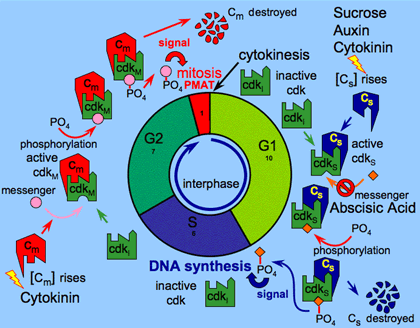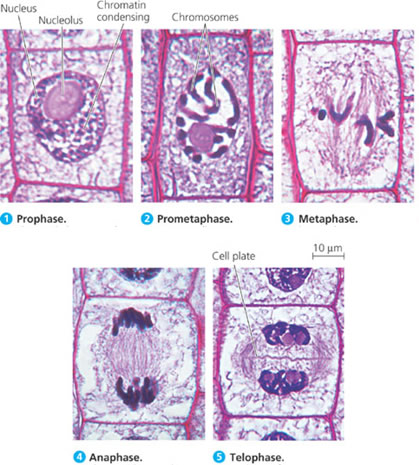 |
| Cell Cycle |
In plants, as in all eukaryotic life-forms, the cell cycle comprises the processes of cell division, constituted by three preparatory phases (G , G , and S), followed by mitosis (nuclear division) and cytokinesis (cytoplasm division).
One of the fundamental characteristics of living organisms is their ability to grow and reproduce. At the cellular level, growth is accomplished by a gain of mass, followed by division into two daughter cells.
In unicellular species, such as bacteria and green algae, this division results in the production of new organisms. In multicellular organisms, such as plants, cells must divide many times to produce new individuals, and additional processes of differentiation into mature cell types must occur.
  |
Eukaryotic Cell Division
Plant cells are eukaryotic, meaning that they contain a nucleus and membrane-bound cellular compartments called organelles, such as chloroplasts, the sites of photosynthesis, and the central vacuole used for storage. In order for eukaryotic cell division to occur, cells must accomplish several steps.
First, a cell must reach a sufficient size to ensure that the daughter cells will be large enough to survive. The cell achieves this status by making needed molecules, using synthetic biochemical reactions, and monitoring the outside environment to ensure continued favorable conditions for reproduction.
Next, a cell must replicate all required macromolecules, including the deoxyribonucleic acid (DNA), as well as the organelles. Finally, the cellmust be able to distribute appropriately the cellular contents, including the genetic material, to the daughter cells. The cyclical repetition of these steps comprises the eukaryotic cell division cycle or, more simply, the cell cycle.
Cell Cycle Phases
The general arrangement of the cell cycle was first determined through microscopic observations of living cells undergoing cell division. Originally, four stages were identified: G1 phase, S phase, G2 phase, and M phase. G1 and G2 phases were named as gap phases, because itwas presumed that the cell did not appear to accomplish any specific events during these phases.
G1 phase occurs after the previous cell division and is the phase where the cell grows, metabolizes, and prepares to undergo another round of cell division. During G1 phase, the cell also transcribes and translates the genes required for DNA synthesis. In S phase, the DNA synthetic phase, the cell concentrates its efforts on accurately replicating its genetic material, the DNA genome.
 |
| Cell Cycle Phases |
In G2 phase, the cell coordinates both transcription and translation to synthesize proteins that are required specifically for asexual cell division, or mitosis. During M phase, the DNA chromosomes condense and are divided into the two daughter cells.G1, S, andG2 phases together are referred to as interphase.
Mitosis itself is composed of four phases:
- prophase, in which chromosomes are condensed, homologous chromosomes are paired together, and the spindle apparatus made of microtubules forms
- metaphase, in which the paired chromosomes are lined up across the center of the cell on the metaphase plate
- anaphase, in which the homologous chromosomes are pulled to separate poles in the dividing cell by the attached spindle apparatus; and
- telophase, in which the daughter cell chromosomes are collected together at the poles.
Because plant cells have cell walls, the division of one cell into two daughter cells requires the formation of a cell plate to complete cytokinesis. This cell plate grows outward between the two new nuclei. Once the cell plate reaches the walls of the dividing cell, it forms the cell wall that separates the two new cells.
Checkpoints
The cell will die if it goes through any cell cycle phase out of order. Therefore, the cell has evolved sophisticated checkpoints to ensure that critical events, such as DNA replication and cell division, occur in the correct order and that each required step is completed prior to movement to the next phase.
Additionally, external conditions, such as a change in nutrient availability, can cause a cellular checkpoint response. There are two main points in the cell cycle which are regulated by checkpoints, the G1-to-S transition and the G2-to-M transition.
The G1-to-S transition is important because once the cell commits to divide and starts to copy its DNA, it must complete cell division or die. After DNA replication is complete, the G2-to-M transition is important for the cell to make sure that all of the DNA has been copied correctly, or the daughter cells will not have the full complement of genetic material.
CDKs and Cyclins
Enzymes are proteins that catalyze chemical reactions in the cell.Without enzymes, chemical reactions would occur too slowly to sustain life. Kinases are enzymes that place a chemical group, called a phosphate group, onto other proteins in the cell.
Because of the nature of the phosphate chemical group, the addition of these groups causes conformational changes in the three-dimensional structure of the proteins that accept them. The cell cycle is controlled by the actions of kinases called cyclin-dependent kinases, or CDKs. Each CDK has a partner called a cyclin, which is required for the kinase activity to place phosphate groups on target proteins.
The CDK/cyclin pairs perform kinase reactions, which activate proteins leading to completion of cell cycle phases. Opposing the action of the CDK and cyclin pairs are cyclin-dependent kinase inhibitors, or CKIs, which act as brakes to prevent CDK/cyclin activity until the cell is ready to go on to the next step in the cell cycle.
Many of the cell cycle control mechanisms have been conserved throughout all eukaryotic cells, including the plant cell. Arabidopsis is a genus that has been widely characterized and used as an experimental model for plant growth and differentiation in scientific laboratories worldwide.
In plants such as Arabidopsis, two major groups of CDKs have been studied, the A-type and B-type CDKs. The A-type CDKs show kinase activity during the S, G2, and M phases of the cell cycle and regulate the transitions from G1-to-S and G2-to-M phases. The B-type CDKs are active during mitosis and regulate only the G -to-M transition in plants.